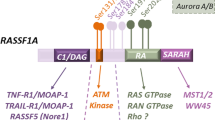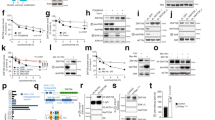Abstract
RASSF2 is a tumour suppressor that in common with the rest of the RASSF family contains Ras association and SARAH domains. We identified the proapoptotic kinases, MST1 and MST2, as the most significant binding partners of RASSF2, confirmed the interactions at endogenous levels and showed that RASSF2 immunoprecipitates active MST1/2. We then showed that RASSF2 can be phosphorylated by a co-immunoprecipitating kinase that is likely to be MST1/2. Furthermore, we showed that RASSF2 and MST2 do indeed colocalize, but whereas RASSF2 alone is nuclear, the presence of MST1 or MST2 results in colocalization in the cytoplasm. Expression of RASSF2 (stably in MCF7 or transiently in HEK-293) increases MST2 levels and knockdown of RASSF2 in HEK-293 cells reduces MST2 levels, in addition colorectal tumour cell lines and primary tumours with low RASSF2 levels show decreased MST2 protein levels. This is likely to be mediated by RASSF2-dependent protection of MST2 against proteolytic degradation. Our findings suggest that MST2 and RASSF2 form an active complex in vivo, in which RASSF2 is maintained in a phosphorylated state and protects MST2 from degradation and turnover. Thus, we propose that the frequent loss of RASSF2 in tumours results in the destablization of MST2 and thus decreased apoptotic potential.
This is a preview of subscription content, access via your institution
Access options
Subscribe to this journal
Receive 50 print issues and online access
$259.00 per year
only $5.18 per issue
Buy this article
- Purchase on Springer Link
- Instant access to full article PDF
Prices may be subject to local taxes which are calculated during checkout







Similar content being viewed by others
References
Agathanggelou A, Cooper WN, Latif F . (2005). Role of the ras-association domain family 1 tumor suppressor gene in human cancers. Cancer Res 65: 3497–3508.
Callus BA, Verhagen AM, Vaux DL . (2006). Association of mammalian sterile twenty kinases, Mst1 and Mst2, with hSalvador via C-terminal coiled-coil domains, leads to its stabilization and phosphorylation. FEBS J 273: 4264–4276.
Cheung WL, Ajiro K, Samejima K, Kloc M, Cheung P, Mizzen CA et al. (2003). Apoptotic phosphorylation of histone H2B is mediated by mammalian sterile twenty kinase. Cell 113: 507–517.
Cooper WN, Dickinson RE, Dallol A, Grigorieva EV, Pavlova TV, Hesson LB et al. (2008). Epigenetic regulation of the ras effector/tumour suppressor RASSF2 in breast and lung cancer. Oncogene 27: 1805–1811.
Creasy CL, Ambrose DM, Chernoff J . (1996). The Ste20-like protein kinase, Mst1, dimerizes and contains an inhibitory domain. J Biol Chem 271: 21049–21053.
Dallol A, Agathanggelou A, Fenton SL, Ahmed-Choudhury J, Hesson L, Vos MD et al. (2004). RASSFIA interacts with microtubule-associated proteins and modulates microtubule dynamics. Cancer Res 64: 4112–4116.
Deng Y, Pang A, Wang JH . (2003). Regulation of mammalian STE20-like kinase 2 (MST2) by protein phosphorylation/dephosphorylation and proteolysis. J Biol Chem 278: 11760–11767.
Durocher Y, Perret S, Kamen A . (2002). High-level and high-throughput recombinant protein production by transient transfection of suspension-growing human 293-EBNA1 cells. Nucleic Acids Res 30: E9.
Endoh M, Tamura G, Honda T, Homma N, Terashima M, Nishizuka S et al. (2005). RASSF2, a potential tumour suppressor, is silenced by CpG island hypermethylation in gastric cancer. Br J Cancer 93: 1395–1399.
Fenton SL, Dallol A, Agathanggelou A, Hesson L, Ahmed-Choudhury J, Baksh S et al. (2004). Identification of the E1A-regulated transcription factor p120(E4F) as an interacting partner of the RASSF1A candidate tumor suppressor gene. Cancer Res 64: 102–107.
Glantschnig H, Rodan GA, Reszka AA . (2002). Mapping of MST1 kinase sites of phosphorylation. Activation and autophosphorylation. J Biol Chem 277: 42987–42996.
Graves JD, Draves KE, Gotoh Y, Krebs EG, Clark EA . (2001). Both phosphorylation and caspase-mediated cleavage contribute to regulation of the Ste20-like protein kinase Mst1 during CD95/Fas-induced apoptosis. J Biol Chem 276: 14909–14915.
Graves JD, Gotoh Y, Draves KE, Ambrose D, Han DKM, Wright M et al. (1998). Caspase-mediated activation and induction of apoptosis by the mammalian Ste20-like kinase Mst1. EMBO J 17: 2224–2234.
Guo C, Tommasi S, Liu L, Yee JK, Dammann R, Pfeifer GP . (2007). RASSF1A is part of a complex similar to the Drosophila Hippo/Salvador/Lats tumor-suppressor network. Curr Biol 17: 700–705.
Hesson LB, Wilson R, Morton D, Adams C, Walker M, Maher ER et al. (2005). CpG island promoter hypermethylation of a novel Ras-effector gene RASSF2A is an early event in colon carcinogenesis and correlates inversely with K-ras mutations. Oncogene 24: 3987–3994.
Hu Y, Liu Z, Yang SJ, Ye K . (2007). Acinus-provoked protein kinase C delta isoform activation is essential for apoptotic chromatin condensation. Cell Death Differ 14: 2035–2046.
Hwang E, Ryu KS, Paakkonen K, Guntert P, Cheong HK, Lim DS et al. (2007). Structural insight into dimeric interaction of the SARAH domains from Mst1 and RASSF family proteins in the apoptosis pathway. Proc Natl Acad Sci USA 104: 9236–9241.
Imai T, Toyota M, Suzuki H, Akino K, Ogi K, Sogabe Y et al. (2008). Epigenetic inactivation of RASSF2 in oral squamous cell carcinoma. Cancer Sci 99: 958–966.
Kaira K, Sunaga N, Tomizawa Y, Yanagitani N, Ishizuka T, Saito R et al. (2007). Epigenetic inactivation of the RAS-effector gene RASSF2 in lung cancers. Int J Oncol 31: 169–173.
Kakeya H, Onose R, Osada H . (1998). Caspase-mediated activation of a 36-kDa myelin basic protein kinase during anticancer drug-induced apoptosis. Cancer Res 58: 4888–4894.
Khokhlatchev A, Rabizadeh S, Xavier R, Nedwidek M, Chen T, Zhang XF et al. (2002). Identification of a novel Ras-regulated proapoptotic pathway. Curr Biol 12: 253–265.
Kriegsheim A, Preisinger C, Kolch W . (2008). Mapping of signaling pathways by functional interaction proteomics. Methods Mol Biol 484: 177–192.
Kumari G, Singhal PK, Rao MR, Mahalingam S . (2007). Nuclear transport of Ras-associated tumor suppressor proteins: different transport receptor binding specificities for arginine-rich nuclear targeting signals. J Mol Biol 367: 1294–1311.
Kuznetsov S, Khokhlatchev AV . (2008). The growth and tumor suppressors NORE1A and RASSF1A are targets for calpain-mediated proteolysis. PLoS ONE 3: e3997.
Lee KK, Ohyama T, Yajima N, Tsubuki S, Yonehara S . (2001). MST, a physiological caspase substrate, highly sensitizes apoptosis both upstream and downstream of caspase activation. J Biol Chem 276: 19276–19285.
Lee KK, Yonehara S . (2002). Phosphorylation and dimerization regulate nucleocytoplasmic shuttling of mammalian STE20-like kinase (MST). J Biol Chem 277: 12351–12358.
Liao X, Siu MK, Chan KY, Wong ES, Ngan HY, Chan QK et al. (2008). Hypermethylation of RAS effector related genes and DNA methyltransferase 1 expression in endometrial carcinogenesis. Int J Cancer 123: 296–302.
Lin Y, Khokhlatchev A, Figeys D, Avruch J . (2002). Death-associated protein 4 binds MST1 and augments MST1-induced apoptosis. J Biol Chem 277: 47991–48001.
Maruyama R, Akino K, Toyota M, Suzuki H, Imai T, Ohe-Toyota M et al. (2008). Cytoplasmic RASSF2A is a pro-apoptotic mediator whose expression is epigenetically silenced in gastric cancer. Carcinogenesis.
O'Neill E, Rushworth L, Baccarini M, Kolch W . (2004). Role of the kinase MST2 in suppression of apoptosis by the proto-oncogene product Raf-1. Science 306: 2267–2270.
Oh HJ, Lee KK, Song SJ, Jin MS, Song MS, Lee JH et al. (2006). Role of the tumor suppressor RASSF1A in Mst1-mediated apoptosis. Cancer Res 66: 2562–2569.
Praskova M, Khoklatchev A, Ortiz-Vega S, Avruch J . (2004). Regulation of the MST1 kinase by autophosphorylation, by the growth inhibitory proteins, RASSF1 and NORE1, and by Ras. Biochem J 381: 453–462.
Rabizadeh S, Xavier RJ, Ishiguro K, Bernabeortiz J, Lopez-Ilasaca M, Khokhlatchev A et al. (2004). The scaffold protein CNK1 interacts with the tumor suppressor RASSF1A and augments RASSF1A-induced cell death. J Biol Chem 279: 29247–29254.
Reszka AA, Halasy-Nagy JM, Masarachia PJ, Rodan GA . (1999). Bisphosphonates act directly on the osteoclast to induce caspase cleavage of mst1 kinase during apoptosis. A link between inhibition of the mevalonate pathway and regulation of an apoptosis-promoting kinase. J Biol Chem 274: 34967–34973.
Scheel H, Hofmann K . (2003). A novel interaction motif, SARAH, connects three classes of tumor suppressor. Curr Biol 13: R899–900.
Ura S, Masuyama N, Graves JD, Gotoh Y . (2001). Caspase cleavage of MST1 promotes nuclear translocation and chromatin condensation. Proc Natl Acad Sci USA 98: 10148–10153.
Ura S, Nishina H, Gotoh Y, Katada T . (2007). Activation of the c-Jun N-terminal kinase pathway by MST1 is essential and sufficient for the induction of chromatin condensation during apoptosis. Mol Cell Biol 27: 5514–5522.
von Kriegsheim A, Pitt A, Grindlay GJ, Kolch W, Dhillon AS . (2006). Regulation of the Raf-MEK-ERK pathway by protein phosphatase 5. Nat Cell Biol 8: 1011–1016.
Vos MD, Ellis CA, Elam C, Ulku AS, Taylor BJ, Clark GJ . (2003). RASSF2 is a novel K-Ras-specific effector and potential tumor suppressor. J Biol Chem 278: 28045–28051.
Acknowledgements
We thank David Sumpton and Willy Bienvenut for the mass spectrometry. This work was supported by Breast Cancer Campaign, Cancer Research UK, Sport Aiding Medical Research for Kids (to FL) and The European Union FP6 project ‘Interaction Proteome’ (LSHG-CT-2003-505520) and Cancer Research UK (to WK).
Author information
Authors and Affiliations
Corresponding author
Additional information
Supplementary Information accompanies the paper on the Oncogene website (http://www.nature.com/onc)
Supplementary information
Rights and permissions
About this article
Cite this article
Cooper, W., Hesson, L., Matallanas, D. et al. RASSF2 associates with and stabilizes the proapoptotic kinase MST2. Oncogene 28, 2988–2998 (2009). https://doi.org/10.1038/onc.2009.152
Received:
Revised:
Accepted:
Published:
Issue Date:
DOI: https://doi.org/10.1038/onc.2009.152
Keywords
This article is cited by
-
Circulating microRNA sequencing revealed miRNome patterns in hematology and oncology patients aiding the prognosis of invasive aspergillosis
Scientific Reports (2022)
-
Evaluation of genetic diversity and management of disease in Border Collie dogs
Scientific Reports (2021)
-
Tumor suppressor C-RASSF proteins
Cellular and Molecular Life Sciences (2018)
-
Comparative Modeling, Molecular Docking, and Revealing of Potential Binding Pockets of RASSF2; a Candidate Cancer Gene
Interdisciplinary Sciences: Computational Life Sciences (2017)
-
STRIPAK complexes in cell signaling and cancer
Oncogene (2016)



